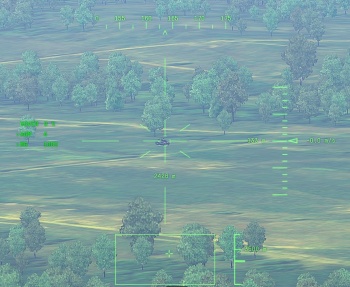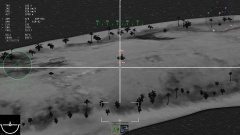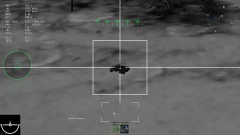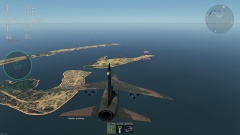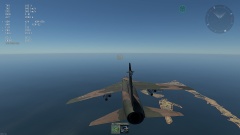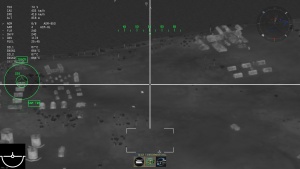Air-to-ground missiles
Contents
Overview
Air-to-ground missiles (AGMs) were added to the game in Update 1.79 "Project X" with the AGM-12B Bullpup. The first of this type of weapon were used in the Vietnam War. In-game, they are a potent weapon to have at your disposal, allowing you to destroy enemy ground or naval targets from several kilometres away. They allow the ability to steer the projectile to engage even moving targets.
Several different types of AGMs exist: Manual Command to Line of Sight (MCLOS) also known as command guided, Semi Automatic Command to Line of Sight (SACLOS), Television guided (TV), Infrared guided (IR), Laser guided, and Beam riding. Note that in-game these guidance systems might work differently than their respective real counterparts or the missiles might use a different guidance system than in reality.
Helicopter guidance
With the exception of self-guiding missiles, all helicopter-launched air-to-ground missiles are guided by the cursor (much like aircraft SACLOS missiles). Most helicopters also feature a gunner view, in which the missile can be directed separately to the helicopter. This can also often be set to centre automatically on a designated point on the ground (the "sight stabilization" keybind), which accounts for the relative motion of the helicopter and maintains the image in the gunner view, thus allowing for smooth guidance of the missile even when the helicopter is performing extreme manoeuvres. Enabling sight stabilization will also display the range to the target in the gunner view. Some more advanced helicopters have the additional option of locking the stabilized sight to a moving target, thus allowing semi-autonomous guidance of the missile.
Attack drones feature a similar view. The maximum range of the missile can be seen in the lower part of the view, in the example it is 3,500 m, and the bigger bar below it shows the range of the currently aimed point.
Manual Command to Line of Sight (MCLOS)
MCLOS guided missiles are typically guided either by physical connection to the launch platform by a wire, or by radio waves. In the case of wire-guided missiles, the wire is unspun from the missile as it flies towards the target. After a missile of this type is launched, the gunner or pilot watches the motor or tracer components of the missile and sends correcting guidance commands to keep the projectile on target.
MCLOS controls
Without steering input from the player, the missile will behave like a simple unguided rocket. It is recommended to check your surroundings and ensure that there are no enemies in the vicinity, as it can be significantly more difficult to attempt to control both missile and aircraft at the same time. The default keybinds for manual missile guidance will prevent you from manoeuvring your aircraft with the keyboard at the same time.
| Command guided missile controls | ||
|---|---|---|
| Control name | Default Keybind (PC keyboard & mouse) |
Description |
| Yaw axis for aim weapons | ⇧ Shift+A / ⇧ Shift+D | Keys to control the yaw (side to side) movement of the missile |
| Pitch axis for aim weapons | ⇧ Shift+W / ⇧ Shift+S | Keys to control the pitch (up and down) movement of the missile |
| Fire air-to-ground missile | Space | Fire the command guided missile |
List of MCLOS AGMs
| Command guided missiles | ||
|---|---|---|
| Missile | Country | Max guidance range |
| AGM-12B Bullpup | |
8 km |
| AGM-12C Bullpup | |
16 km |
| AS-20 Nord | |
8 km |
| AS-30 Nord | |
10 km |
| Kh-23M | |
10 km |
| Ki-148 I-Go Model 1B | |
12 km |
| Rb05A | |
8 km |
Semi Automatic Command to Line of Sight (SACLOS)
The SACLOS guidance system improves on MCLOS by having a device that calculates correction commands such that the gunner only has to point the sight of the targeting device at the target, and the appropriate correction commands will be performed by the device. Connection to the missile can be by wire or radio waves. The targeting device often features a significantly zoomed-in view which makes target acquisition easier. All this makes targeting and guidance much easier and even allows for moderate changes of aircraft movement at the same time.
SACLOS controls
When launched from an aircraft, the SACLOS guided missile will fly towards the direction in which the aircraft's nose is pointing. This can allow for much easier and more accurate targeting than MCLOS missiles with fine adjustments using the mouse, but means that ample time should be given to allow the aircraft to pull up after the missile has struck.
List of SACLOS AGMs
| SACLOS guided missiles | ||
|---|---|---|
| Missile | Country | Max guidance range |
| 9M14-2 Malyutka-2 | |
3 km |
| 9M14M Malyutka | |
3 km |
| 9M17M Falanga | |
4 km |
| 9M114 Shturm | |
5 km |
| 9M120 Ataka | |
6 km |
| AGM-12B Bullpup | |
11 km |
| AGM-22 | |
3.5 km |
| AS.11 | |
3.5 km |
| AS.12 | |
7 km |
| BGM-71C Improved TOW | |
3.75 km |
| BGM-71D TOW-2 | |
3.75 km |
| HJ-8A | |
3 km |
| HJ-8C | |
3 km |
| HJ-8E | |
4 km |
| HJ-8H | |
4 km |
| HOT-1 | |
4 km |
| HOT-2 TOW | |
4 km |
| HOT-3 | |
4 km |
| Kh-66 | |
10 km |
| RB 52 A | |
3.5 km |
| RB 53 Bantam | |
2 km |
| RB 55B Heli TOW | |
3.75 km |
| RB 55C Heli TOW | |
3.75 km |
Television
In War Thunder, television-guided missiles refer to a class of missile guided by "optical contrast seekers". These missiles have a camera in the nose that transmits a greyscale image to the pilot, allowing them to select and lock onto a high contrast static or moving target. The missile will guide itself towards the target, leaving the pilot free to manoeuvre the aircraft and evade any anti-air defences. As the camera does not provide any infrared information, it may sometimes be accidentally locked onto high contrast objects in the vicinity of the intended target instead, which can cause a miss if the target subsequently moves away from the area. Television guided missiles are also unable to be used at night and in other low visibility conditions such as adverse weather. Some planes and AGMs however have IR or thermal imaging and can be used at night and have better targeting quality. Often an additional targeting pod is needed for this, which will take up one pylon.
| TV guided missile controls | ||
|---|---|---|
| Control name | Default Keybind (PC keyboard & mouse) |
Description |
| Optical Seeker View | ? | Switch to the TV targeting view. It is not necessary to use this, but it has better zoom usually than 3rd person view. |
| Weapon lock (air-to-ground) | ? | First press: Turn Seeker on. Second press: Try to lock on target. |
| Fire air-to-ground missile | ? | Fire missile. If no lock is activated it will first turn the seeker and target locking mode on. |
| Activate Target point | ? | Lock TV camera to a point in world space. It is not a weapon lock! It will always try to look at it. You can use it to lock a area from 3rd person view look around so it will later be easier to fine tune your target lock. |
| Deactivate Target point | ? | If target point is not used always deactivate it to not have the TV camera point there. |
List of TV guided missiles
| TV guided missiles | ||
|---|---|---|
| Missile | Country | Max guidance range |
| AGM-65A | |
23 km |
| AGM-65B | |
23 km |
| AGM-65H | |
23 km |
| AJ.168 | |
45 km |
| Flz Lwf LB 82 | |
23 km |
| Kh-29T | |
13 km |
| Kh-29TD | |
35 km |
| Kh-29TE | |
30 km |
| RB 75 | |
23 km |
| RB 75T | |
23 km |
IR
Infrared homing missiles are similar in use to TV guided missiles, but feature an infrared imaging system instead of the optical camera, allowing heat sources (such as tanks) to be more easily differentiated and locked onto in cluttered environments and under low optical visibility conditions such as night-time.
List of IR guided AGMs
| IR guided missiles | ||
|---|---|---|
| Missile | Country | Max guidance range |
| AGM-65D | |
23 km |
| AGM-65G | |
23 km |
| Kh-38MT | |
40 km |
| PARS 3 LR | |
7 km |
| Spike ER | |
8 km |
Laser
The aircraft points a target-illuminating laser onto the desired target and when the missiles is fired it will fly automatically towards the laser point on the target. Advanced laser guided missiles can operate even when the laser illumination is stopped and will continue its flight path on inertial guidance. If the laser illumination lights up again they will proceed to follow the laser light.
List of laser guided AGMs
| Laser guided missiles | ||
|---|---|---|
| Missile | Country | Max guidance range |
| AGM-65L | |
23 km |
| AGM-114B Hellfire | |
8 km |
| AGM-114K Hellfire II | |
8 km |
| AGM-123 Skipper | |
20 km |
| AKD-9 | |
6 km |
| AKD-10 | |
10 km |
| APKWS II (M151) | |
11 km |
| APKWS II (M282) | |
11 km |
| AS-30L Nord | |
12 km |
| Blue Arrow 9 | |
6 km |
| CIRIT | |
10 km |
| GATR | |
10 km |
| Kh-25 | |
7 km |
| Kh-25ML | |
10 km |
| Kh-29L | |
10 km |
| Kh-38ML | |
40 km |
| L-UMTAS | |
8 km |
| S-25L | |
10 km |
| ZT-6 Mokopa | |
10 km |
Beam riding
Beam riding missiles are operated using a radar or laser beam to guide them to the target. Once launched, the missile will attempt to keep itself in the centre of the beam that is projected out from the launch platform.
This differs from other laser-guided missiles, in that the missile is guided by the laser beam itself rather than guiding towards the reflection of the laser on the target.
List of beam riding AGMs
| Beam riding missiles | ||
|---|---|---|
| Missile | Country | Max guidance range |
| 9K127 Vikhr | |
10 km |
| 9M120-1 Ataka | |
6 km |
| 9M123 Khrizantema | |
6 km |
| Starstreak | |
7 km |
Active Radar Homing
Active radar homing (ARH) missiles have a radar emitter built in so that they don't have to rely on target illumination by the aircraft that fired it, making them fire-and-forget weapons. Unfortunately, this is only true to an extent: ARH mode is only available when the missile is coming close to the target, as the range of the built-in radar is limited by its size, which needs to fit inside the compact missile. During the first stage of the flight, the missile has to either rely on inertial guidance, act like a SARH missile, or be course-corrected by Datalink from the aircraft.
List of active radar homing AGMs
| ARH missiles | ||
|---|---|---|
| Missile | Country | Max guidance range |
| AS.34 Kormoran | |
32 km |
Media
- Videos
See also
External links
- Devblogs
- [Devblog] Missile duels: fair play
- [Devblog] New features upcoming with the "Ixwa Strike" update - Tactical air-to-surface missiles
- [Devblog] AGM-12B Bullpup: They can't dodge
- Wikipedia


